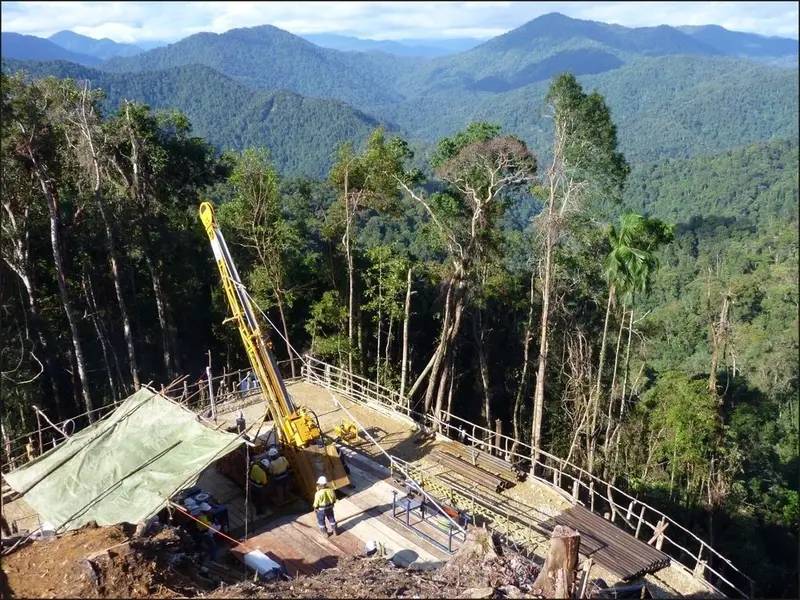
The latest investor disappointment at Triple Plate Junction's (TPJ:AIM) exploration shows the pains with backing a company that doesn't produce the goods. Low-grade drill results are the reason behind the stock slumping by a fifth today (12 Feb) to 0.6p.
This represents the latest in a series of major setbacks for the Papua New Guinea-based prospector which has seen the share price fall 92% since April 2011.
Triple Plate was always going to be a binary trade as the expectations were set too high. The shares would soar if it found lots of metal; they would slump if it didn't find enough.
That could be true of any mining investment, except Triple Plate was different. When you have the right to explore land next to one of the world's biggest copper/gold discoveries, investors expect miracles.
One of the best places to look for natural resources is next to an existing mine or proven discovery. The hope is that the neighbour's mineralisation continues into your licence area. Sadly for Triple Plate, this theory is not 100% fool-proof.
The discovery in question is the Wafi-Golpu project, a 50:50 joint venture between Harmony Gold Mining (HMY:NYSE) and Newcrest Mining (NCM:ASX). A report last year said the mine would cost $4.85 billion to bring into production for annual output of 490,000 ounces of gold and 290,000 tonnes of copper. The deposit contains an estimated 12.4 million ounces of gold and 5.4 million tonnes of copper. It is a giant.
Triple Plate has two exploration assets in close proximity to Wafi-Golpu. One of which is a 25% stake in a joint venture with Newmont Mining (NEM:NYSE) on the Morobe prospect. A brief history lesson is required before we proceed.
Management in 2009 tried to issue new shares to recapitalise Triple Plate and subsequently tried to delist the company - both moves were rejected by shareholders. A new management team was brought in and a £2.5 million placing in November 2010 injected new life into the business. During the placing process, it was revealed that Newmont tried to capitalise on its position as 10.1% shareholder to buy the small cap miner at 4p per share but a deal didn't go ahead.
This takeover approach, combined with a revived balance sheet and proximity to Wafi-Golpu, put Triple Plate on the radar of a wider investor community. Indeed, Shares featured the stock as one of our picks for 2011, recognising the potential gains should its exploration work be successful. What followed was a series of disappointments, culminating in today's meagre share price.
Triple Plate has four main projects, all of which have been dependent on joint venture partners being proactive with exploration. Newmont dragged its heels with Morobe and said two months ago that it wouldn't allocate any money in 2013 for exploration following poor results. Last month it was announced that Newmont had given up altogether on the search for a large metal deposit at Morobe.
The other asset close to Wafi-Golpu is the Wamum project, a joint venture with Barrick Gold (ABX:NYSE) where Triple Plate has a 12.1% stake. Again, poor results led to disinterest from Barrick. Some field work was done last year and results are overdue.
In both cases, we expect Triple Plate to find a way to go it alone. Indeed, the miner has already revealed that it wants to look at high-grade prospects at Morobe which might have been considered too small to explore by Newmont. An announcement on this matter is expected by early March.
Triple Plate criticised joint venture partner Gold Anomaly (GOA:ASX) for not looking in the right places on its Crater Mountain project. While there was subsequent exploration success, Triple Plate decided not to keep paying its share of exploration costs because work was slow (due to its partner's fragile financial situation) and has subsequently been diluted to 8%.
Today's drill results are the subject of Manus Island, a joint venture with Newcrest which has examined two areas. The first, Kisi, didn't come up with decent results. Today's announcement features the second area, Arie. The grades are very low. They might be good enough to build a mine if the companies can find very large quantities of metal, but that is a big 'if'. Papua New Guinea's mining costs are much higher than most other places in the world so projects with only marginal grades - as implied by the latest drill results - are unlikely to be economic.
There was a fifth project in Vietnam. Having spent £1 million on exploration, Triple Plate declared it uneconomic and sold the asset to exploration director Bill Howell. Several major mining houses looked at the project last summer but no-one wanted to invest.
So where now? Triple needs to reinvest itself or give up. Last November it said there was enough money to fund work into 2014. If it goes solo on any of the joint ventures, cash burn could increase, leaving it short of money sooner than previously indicated.
The company has been refinanced three times in the past two years and now operates on a skeleton basis. The chief executive has been pushed out and will leave the company in a fortnight's time. The media advisers were let go last summer to save money. The information on its website now looks very out of date in places. Unless something changes, the business will crumble into a pile of bones.
Triple Plate is a lesson in how mining investments can be very high risk. It also shows the importance of miners being in control of their own destiny. Triple Plate sat on its hands for months waiting for partners to do work. If it had taken control of the exploration, one might have seen a faster pace of work and possibly something more substantial, albeit smaller scale than its partners desired. The company was very aware of this predicament two years ago when I last looked at the stock in detail. It paid the price for not taking decisive action. Now it must prove its worth, but will any investor still want to be strapped in for the ride?




